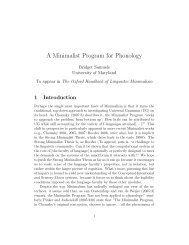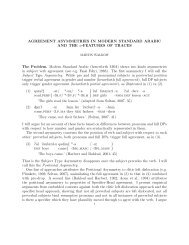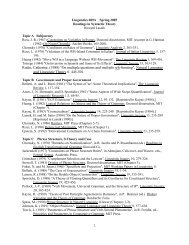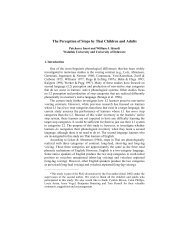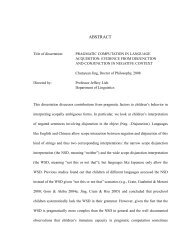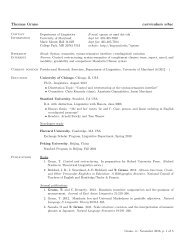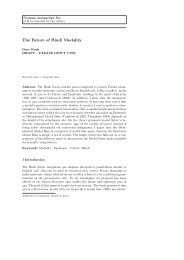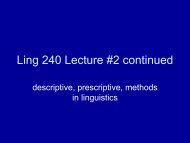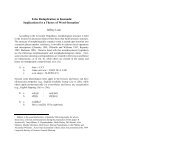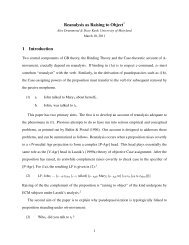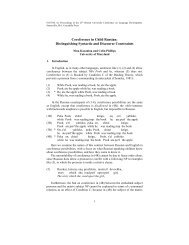Rogalsky & Hickok (2008) - Linguistics
Rogalsky & Hickok (2008) - Linguistics
Rogalsky & Hickok (2008) - Linguistics
Create successful ePaper yourself
Turn your PDF publications into a flip-book with our unique Google optimized e-Paper software.
Cerebral Cortex Advance Access published July 31, <strong>2008</strong>Cerebral Cortexdoi:10.1093/cercor/bhn126Selective Attention to Semantic andSyntactic Features Modulates SentenceProcessing Networks in AnteriorTemporal CortexCorianne <strong>Rogalsky</strong> and Gregory <strong>Hickok</strong>Center for Cognitive Neuroscience & Department of CognitiveSciences, University of California, Irvine, CA 92697, USANumerous studies have identified an anterior temporal lobe (ATL)region that responds preferentially to sentence-level stimuli. It isunclear, however, whether this activity reflects a response tosyntactic computations or some form of semantic integration. Thisdistinction is difficult to investigate with the stimulus manipulationsand anomaly detection paradigms traditionally implemented. Thepresent functional magnetic resonance imaging study addressesthis question via a selective attention paradigm. Subjects monitoredfor occasional semantic anomalies or occasional syntactic errors,thus directing their attention to semantic integration, or syntacticproperties of the sentences. The hemodynamic response in thesentence-selective ATL region (defined with a localizer scan) wasexamined during anomaly/error-free sentences only, to avoidconfounds due to error detection. The majority of the sentencespecificregion of interest was equally modulated by attention tosyntactic or compositional semantic features, whereas a smallersubregion was only modulated by the semantic task. We suggestthat the sentence-specific ATL region is sensitive to both syntacticand integrative semantic functions during sentence processing,with a smaller portion of this area preferentially involved in thelater. This study also suggests that selective attention paradigmsmay be effective tools to investigate the functional diversity ofnetworks involved in sentence processing.Keywords: ATL, fMRI, language, semantics, speech, syntaxIntroductionIdentification of neural circuits supporting sentence-levelprocessing in comprehension remains an important but elusivegoal in cognitive neuroscience. In order to process a spokensentence, the listener must not only process word-levelphonological, semantic, and syntactic information, but alsosentence-level syntactic and semantic properties. Broca’s areatraditionally has been the central focus in investigatingthese sentence-level processes (Caramazza and Zurif 1976;Linebarger et al. 1983; Caplan et al. 2000), but more recentwork has suggested that Broca’s area plays only a limited role inreceptive syntax (Grodzinsky 2000). Thus, investigations ofsyntactic processing have begun to target other corticalregions, particularly the anterior temporal lobe (ATL) (Mazoyeret al. 1993; Dronkers et al. 1994, 2004; Stowe et al. 1999;Friederici and Von Cramon 2000; Friederici et al. 2000;Humphries et al. 2001, 2005; Meyer et al. 2003). Some of thesestudies are reviewed below to summarize the known responseproperties of the ATL during sentence comprehension. (In thecontext of studies of sentence processing, the relevant regionsof the ATL are on the lateral aspect and may include [in variousstudies] structures ranging from those in the superior temporalsulcus to the inferior temporal gyrus.)Neuropsychological data have provided evidence implicatingthe ATL in sentence processing. Dronkers et al. (2004) testedpatients with focal brain lesions using a sentence comprehensionbattery that included various degrees of morphosyntacticcomplexity. Performance on this comprehension test wasexamined in relation to lesion location. Damage to the left ATL(anterior Brodmann Area (BA) 22) was correlated with deficitsin sentence comprehension and appeared to affect comprehensionof all but the simplest sentence structures, such asdeclarative sentences. The authors concluded that the ATL islikely involved in ‘‘very basic aspects of morphosyntacticcomprehension’’ (Dronkers et al. 2004).In functional imaging research, Mazoyer et al. (1993) wereamong the first to observe that anterior temporal regionsrespond fairly selectively to sentence-level stimuli. Theirpositron emission tomography study compared brain activationassociated with listening to sentences in the subjects’ nativelanguage, sentences in an unfamiliar language, pseudowordsentences (content words replaced with nonwords), semanticallyanomalous sentences, and word lists. Thus, 3 of thestimulus conditions contained syntactic information that wasaccessible to the subject (the normal sentences, the pseudowordsentences, and the semantically anomalous sentences),whereas the other 2 conditions did not. Mazoyer et al. foundthat the ATL, bilaterally, was activated during the perception ofthe 3 syntactically structured stimulus conditions, but notduring the perception of the nonstructured stimuli. Broca’sarea did not show the same response pattern, but rather wasactivated during the presentation of both word lists andsentences in the subjects’ native language, but not during theother structured conditions. Other studies have confirmed thatthe response to speech stimuli in Broca’s area does not trackwith the presence or absence of syntactic information(Humphries et al. 2001, 2005, 2006).A number of recent functional imaging studies havecorroborated Mazoyer et al.’s findings. Regions of the ATL aremore active while listening to sentences than to word lists,scrambled sentences, and environmental sound sequences;pseudoword sentences also appear to drive anterior temporalactivation compared with numerous control conditions(Mazoyer et al. 1993; Stowe et al. 1999; Friederici and VonCramon 2000; Friederici et al. 2000; Humphries et al. 2001,2005). Again, Broca’s area is not consistently activated insentence minus nonsentence contrasts in these studies.The above studies all used stimulus manipulations in thecontext of cognitive subtraction approaches to isolate syntacticprocessing. Other paradigms have also found evidence that theATL participates in syntactic aspects of sentence processing.For example, Friederici and colleagues have used anomalyÓ The Author <strong>2008</strong>. Published by Oxford University Press. All rights reserved.For permissions, please e-mail: journals.permissions@oxfordjournals.org
<strong>Rogalsky</strong>detection paradigms within both electrophysiological andfunctional magnetic resonance imaging (fMRI) contexts toinvestigate the functional neuroanatomy of syntactic processing(Rosler et al. 1993; Meyer et al. 2000; Hahne and Friederici2002; Friederici et al. 2003; among others). Friederici et al.’sevent-related potential work suggests that syntactic anomalieselicit an early left anterior negativity, which is suggested to belinked to inferior frontal gyrus and anterior superior temporalfunction (Friederici and Kotz 2003). Anomaly paradigms usingfMRI also have demonstrated increases in left ATL activity dueto syntactic violations (Meyer et al. 2000; Friederici et al. 2003).Although many authors have attributed ATL sentenceselectivity to the region’s role in syntactic processes, otherinvestigators have considered a possible role for the ATL incombinatorial semantics (Vandenberghe et al. 2002), that is,the process of combining syntactic and lexical-semanticinformation to derive sentence meaning (e.g., the operationsthat lead to different interpretations of Dog bites man vs. Manbites dog). For example, Vandenberghe et al. examinedactivations associated with reading semantically coherentsentences, semantically random sentences (content wordsrandomly chosen), and scrambled versions of each ofthese stimuli. Consistent with the studies discussed above,Vandenberghe et al. identified a region of the ATL thatresponded preferentially to structured sentences independentlyof the semantic coherence of the stimuli. However, they alsofound a subarea of the ATL that showed greater activity forstructured sentences than for scrambled sentences, but onlywhen the structured sentences were semantically coherent. Theauthors argued that this interaction between syntax andsemantics indicates that this ATL area might be involved incompositional semantics. Humphries et al. (2006) conducteda similar experiment in which stimuli were sentences, semanticallyrandom sentences, pseudoword sentences, or scrambledversions of each. Although they replicated the main effect ofsyntactic structure in the ATL (activation greater for sentencesthan unstructured noun lists), they found that the semanticmanipulations produced effects in the opposite direction ina subregion of the ATL with normal (semantically congruent)sentences leading to greater activation than semantically randomor pseudoword sentences. Task differences (one-back vs. ratingsof meaningfulness) were cited as a possible explanation for thediscrepancy. Nonetheless, both studies did uncover evidence fora possible partitioning of the ATL into one region that is primarilyresponsive to syntactic structure and another that is sensitive tocompositional semantic processes.Both Vandenberghe et al. and Humphries et al. used stimulusmanipulations to assess the relative contributions of syntacticversus combinatorial semantic computations in the ATL duringsentence processing. One problem with this approach is that itinvolves the processing of atypical sentences (semanticallyrandom and/or scrambled sentences), and it is unclear how thisrelates to processing normally structured and semanticallycoherent structures because it is difficult or impossible tomanipulate one of these dimensions without affecting the other.A similar problem plagues studies that examine brain responses tosyntactic violations: it is unclear whether this manipulationhighlights regions involved in normal syntactic computation, orregions that are reactive to error detection (or both).The goal of the present study was to assess the relativecontributions of the ATL to syntactic versus combinatorialsemantic operations using a paradigm that does not rely onprocessing atypical sentences, or on stimulus manipulations atall. To this end, we employed a selective attention paradigm tomodulate attention between syntactic and sentence-levelsemantic processes. Selective attention has been shown toeffectively modulate neural activity in visual, auditory, andlinguistic tasks (Corbetta et al. 1990; Platel et al. 1997; Chawlaet al. 1999; Ni et al. 2000; Von Kriegstein et al. 2003; Cant andGoodale 2007). In an fMRI study, we asked participants toattend either to syntactic or compositional semantic aspects ofnormally structured and semantically coherent sentences.Vigilance was monitored by including occasional syntactic orsemantically anomalous sentences, which crucially, wereexcluded from the fMRI analysis. This paradigm has theadvantage that stimuli can remain constant across conditions(sentences were in fact identical in both the semantic andsyntactic attention conditions across subjects) and we canexamine brain responses during the processing of normallystructured and semantically coherent sentences. We wereparticularly interested in determining whether 2 distinct ATLregions would be identified using this paradigm: one that isprimarily sensitive to syntactic operations and therefore shouldshow increased activation during attention to syntacticproperties of sentences, and another region primarily sensitiveto compositional semantic operations and therefore shouldshow increased activation during attention to compositionalsemantic properties of sentences.Regions of interest (ROIs) in the ATL were localized byidentifying areas more active for correct sentences than nounlists. We then determined whether attention to syntactic orcombinatorial semantic features could modulate activity inthese ATL regions. If the ROIs are involved in syntacticcomputations, it is predicted that attending to the syntacticinformation of correct meaningful sentences would lead to anincrease in the blood oxygenation level--dependent (BOLD)response in these regions. Alternatively, if ATL regions arerecruited in combinatorial processing, attending to the overallmeaning of correct meaningful sentences should modulateneural activity.Materials and MethodsParticipantsFourteen right-handed native English speakers (9 males, 5 females;mean age = 23 years, range 19--31) participated in this study. Allparticipants were free of neurological disease (self report) and gaveinformed consent under a protocol approved by the InstitutionalReview Board of the University of California, Irvine.Experiment Design and StimuliOur event-related experiment consisted of the subject listening toindividual sentences and, in separate runs, either making syntacticacceptability or semantic anomaly judgments. Specifically, in thesyntactic task, subjects were instructed to press a response buttonwhen they heard a syntactic error, whereas in the semantic task theywere instructed to press a response button when they heard a semanticanomaly. Subjects were given several examples of each error type andcompleted practice trials prior to scanning to ensure mastery of bothtasks.Unacceptable/anomalous sentences occurred in 20% of trials (10%syntactically unacceptable, 10% semantically anomalous), and occurredat the same frequency in both task conditions so that the only variablemanipulated was the task (pressing a button upon detecting a syntacticerror or detecting a semantic anomaly). A given sentence onlycontained one type of violation. Only the correct (error-free) sentencesPage 2 of 11 Selective Attention Modulates Sentence Networksdand <strong>Hickok</strong>
were used in the analysis to avoid measuring activations associated witherror detection.Subjects participated in 5 scanning runs. The first was a ‘‘localizer’’designed to identify regions that demonstrate relatively selectiveresponses to sentences, as have been found in several previous studies.This run consisted of 20 sentences and 20 noun lists presented ina random order, again following prior experiments (Mazoyer et al.1993; Humphries et al. 2006). In this localizer run, subjects were askedto listen attentively to all stimuli, but made no overt responses (i.e.,‘‘passive listening’’).In 2 of the remaining runs, subjects were instructed to press a buttonwhenever they heard a syntactic violation. In the 2 other runs, subjectswere instructed to press a button when a semantic anomaly occurs.Button box responses to the error/anomaly detection tasks wererecorded. These responses were used to ensure that the subjects wereattending to the correct sentence features and to remove false alarmtrials from the imaging analysis. Across subjects, the order of thesyntactic and semantic runs was counterbalanced. Each run consistedof 60 trials (48 correct, 6 syntactically unacceptable, 6 semanticallyanomalous). Each trial consisted of a warning tone (1 s), the sentence(3 s), and a rest period of 10, 12, or 14 s.All stimuli were recorded by a male speaker and edited usingAudacity sound-editing software. Stimuli in the localizer run weresentences and noun lists, matched for length (see Appendix A). Thesentences included active and passive constructions, each containingeither a prepositional phrase or relative clause. The noun lists consistedof common nouns, each one to 3 syllables in length. The nouns wererecorded as individual words, rather than as a list with ‘‘list intonation.’’The nouns were arranged into lists pseudorandomly with the constraintthat the lists matched the sentences in terms of overall syllable length.We used noun lists (versus including verbs and closed-class items) inorder to decrease the probability that subjects would unconsciously tryto extract sentence-like structure from the lists.Stimuli in the experimental runs (see Appendix A) were sentences ofthe form (noun phrase--aux verb--noun phrase), where one of the nounphrases was modified by a prepositional phrase, for example:The vase on the desk was holding some flowers.The mechanic was fixing a bus in the garage.Syntactic violations were restricted to number agreement betweendeterminer and noun (*A vases, or *those vase) or between noun andverb (*the vases was...). This allowed us to position the violation inearly, middle, or late stages of the sentence, thus requiring subjects toattend to the entire sentence. The prepositional phrase allowed us toensure that subjects were processing the structure hierarchicallyrather than simply using an adjacency strategy (*the vases on the deskwas...).Semantic (i.e., pragmatic) violations involved thematic role incompatibility(#the flowers were holding the vase...), or incompatibilitybetween the noun and the prepositional phrase (#the desk on thevase...). Again, this allowed us to place the anomaly in an early, middle,or late position in the sentence. A given error sentence contained onlyone type of violation. No subject heard more than one version ofa given sentence, but sentences were balanced equally across subjects,and task conditions; i.e., the exact same sentences appeared in bothtask conditions, thus ensuring that nuisance variables such as wordfrequency, concept familiarity, and length were precisely controlled.fMRI Data Acquisition and ProcessingData were collected at the University of California Irvine’s Phillips-Picker1.5 Tesla scanner. A high-resolution anatomical image was acquired, inthe axial plane, with a 3D fat-suppressed gradient recalled echo pulsesequence for each subject (field of view [FOV] = 250 mm, time repetition[TR] =13 ms, flip angle = 20°, voxel size = 1mm 3 1mm 3 1 mm).Functional MRI data was collected using single-shot echo-planar imaging(FOV = 250 mm, TR = 2s,TE= 40 ms, flip angle = 90°, voxel size = 1.95mm 3 1.95 mm 3 5 mm). MRIcro (Rorden and Brett 2000) was used toreconstruct the high-resolution structural image, and an in-house Matlabprogram was used to reconstruct the echo-planar images. Functionalvolumes were aligned to the sixth volume in the series using a 6-parameter rigid-body model to correct for subject motion (Cox andJesmanowicz 1999). Each volume then was spatially filtered (full widthhalf maximum = 8 mm) to better accommodate group analysis.Data AnalysisAnalysis of Functional NeuroImaging software (http://afni.nimh.nih.gov/afni) was used to perform a multiple regression analysis on the timecourse of each voxel’s BOLD response for each subject (Cox and Hyde1997). Regressors for each condition (passive listening to sentences,passive listening to noun lists, perception of correct sentences during thesyntactic task, perception of correct sentences during the sentence-levelsemantic task, and perception of incorrect/anomalous sentences duringboth tasks) were generated. These regressors (in addition to motioncorrection parameters and the grand mean) were convolved witha hemodynamic response function to create predictor variables foranalysis. An F-statistic was calculated for each voxel, and activation mapswere created for each subject to identify regions that were more activewhile listening to each type of stimuli compared with baseline scannernoise. The functional maps for each subject were transformed intostandardized space and resampled into 1 3 1 3 1 mm voxels (Talairach andTournoux 1988) to facilitate group analysis.As reviewed in the introduction, previous studies have found 1) thata region in the ATL is relatively sentence-specific in its BOLD responseand 2) this region contains 2 subareas: one which appears to be moreresponsive to syntactic processing and another which appears to bemore responsive to compositional semantic processing. As a part of ouranalysis strategy, therefore, we sought to identify an ATL ROI that isrelatively sentence specific, and then to determine if subregions weremodulated by the syntactic versus compositional semantic task. Wedefined the ATL ROI as previous studies have, by contrasting sentenceswith noun lists: a repeated-measures t-test was performed to identifyvoxels that were more active during passive listening to sentences thanto noun lists across subjects.Analysis of Attention ModulationAnalysis of attentional effects proceeded along 2 paths. In one analysis,we mapped regions that were responsive to the perception ofsentences during the syntactic task versus rest, the semantic taskversus rest, or the conjunction of the 2. The resulting activation mapsthen were examined in relation to the localizer-defined ROI. Ina second analysis, we assessed whether there were any differential taskeffects within the ATL localizer-defined ROI by directly contrasting the2 attentional task conditions.Additionally, although inferior frontal regions were not identified bythe sentence localizer, we explored the effects of our task manipulationon inferior frontal regions due to their frequent implication in sentenceprocessing via various anomaly paradigms and stimulus manipulations.ROIs were defined by identifying inferior frontal regions whoseactivation passed threshold during the perception of correct sentencesin either the syntactic or semantic task, or in both tasks. The responseproperties of these ROIs were further described by calculating acrosssubjects the mean peak BOLD response during each task as well as forduring the passive listening to sentences and noun lists.ResultsBehavioral DataResponse accuracy rates approached ceiling performance inboth the syntactic (M = 95.7%) and semantic (M = 98%) tasks. Arepeated-measures t-test indicates that there was no significantdifference between performance on the 2 tasks: t (13) = 0.61,P = 0.55.Sentence LocalizerA voxel-wise repeated-measures t-test identified anteriortemporal regions that were more active during passive listeningto sentences compared with noun lists across subjects. VoxelsCerebral Cortex Page 3 of 11
<strong>Rogalsky</strong>responding more to sentences than noun lists (P = 0.01) werefound in the left ATL (–47 17 –18) and right ATL (52 18 –20)(see Fig. 1A). No other regions were more active for sentencesthan for noun lists at this threshold. The relatively liberalthreshold of P = 0.01 was used because 1) the ‘‘localizer’’ scanwas comprised of a single run, and thus did not contain as manystimuli as has been typically used in previous studies ofsentences compared with unstructured word strings and 2)this activation focus was used as an independently identifiedROI for subsequent analyses; therefore we did not wanta stringent threshold to exclude regions from this ROI thatmay be sensitive to sentence structure.Overall Task EffectsBilateral temporal and frontal regions typically implicated inspeech processing were active during the perception ofcorrect sentences in one or another task condition (or both)compared with rest (see Fig. 1B). (Correct sentences weredefined as sentences that did not contain a syntactic orsemantic error and were identified as correct by the subject.Only responses to correct sentences thus defined wereanalyzed; all results reported below are from this set of correctitems.) The P = 0.005 threshold (0.001 is typical) was used tomap the task effects to ensure that close, but subthresholdeffects were not obscured in this descriptive analysis. Regionsthat passed threshold during both task conditions includeda large swath of activation along the superior and middletemporal gyri, as well as some smaller clusters in posteriorfrontal cortex. Regions that were significantly active during thesemantic but not the syntactic task included a large leftposterior temporal area (#2 in Fig. 2A), sites in the ATLbilaterally, and smaller clusters in posterior frontal cortex. Focalactivations that reached threshold for the syntactic, but not thesemantic task were also found in posterior temporal areas,dorsal STG, ATL, and several frontal regions including premotorareas and Broca’s region. Table 1 lists activation foci inTalairach coordinates, and Figure 2 shows amplitudes for bothtasks in each activation focus (relative to rest), as well as theamplitudes for sentences and noun lists in the sentencelocalizer scan. Note that the relatively small differences inamplitude between task conditions is not surprising given thatin both conditions, subjects are processing both syntactic andcompositional semantic information. Our methodological goalwas to use a selective attention manipulation to modulate thebaseline activity in order to highlight relative processingdifferences between regions. It is clear from the data presentedin Figures 1 and 2, that the study was successful in this respect.Our theoretical goal in this study was to examine task effectsin ATL regions. The whole brain activation maps show that ATLregions, generally, appear to contain functionally differentiatedFigure 1. (A) Anterior temporal regions more active for sentences than noun lists in the localizer run across subjects (P \ 0.01). (B) Regions active during the perception ofcorrect sentences in both tasks, and each task respectively, compared with rest across subjects, (P \ 0.005). Regions indicated by an arrow and outlined in black correspond toregions identified by the sentences [ noun list contrast shown in (A).Page 4 of 11 Selective Attention Modulates Sentence Networksdand <strong>Hickok</strong>
Figure 2. Mean peak amplitudes of selected clusters in the left (A) and right (B) hemispheres active during the perception of correct sentences in at least one task, comparedwith rest (P \ 0.005), averaged across trials and subjects. Mean peak amplitudes are shown for each task, as well as for the passive listening to sentences and noun lists in thelocalizer run. Each cluster’s number corresponds to the activation map, as well as to Table 1. Error bars represent 95% confidence intervals.subfields, some of which are significantly activated only for thesemantic task, some only for the syntactic task, and some forboth tasks. But, activations associated with sentence processingcompared with a resting baseline could be attributable to anynumber of processing stages ranging from acoustic analysis tocompositional semantic computations. For this reason, we wereparticularly interested in the relation between the task effectson the one hand, and the sentence localizer ROIs on the other, asthe sentence localizer should isolate sentence-level processes.Within these ROIs (black outlines in Fig. 1B), activation patternswere not uniform. Some clusters were active for the semantictask only (bilateral), some smaller clusters were active for thesyntactic task only (right hemisphere), and some were active forboth tasks (bilateral). The bulk of the left hemisphere sentenceROI responded to both tasks, whereas the right hemisphere ROIappeared more heterogeneous.Thresholding effects in the above analysis, however, couldeither 1) obscure important differences in the modulation ofthe ATL ROI by the 2 task conditions (e.g., if both tasks areabove threshold but nonetheless differ significantly from oneanother), or 2) falsely suggest that differences between taskconditions exist, when they do not (e.g., if one task barelyCerebral Cortex Page 5 of 11
<strong>Rogalsky</strong>Table 1Talairach coordinates for the sentence localizer ROIs, as well as for the largest clusters (i.e., contiguous voxels) that are active during the perception of correct sentences in at least one task, comparedwith rest (P \ 0.005), averaged across trials and subjectsCenter of massRegion Brodmann area(s) x y zSentence localizer L STG 38 47 17 18R STG 38 52 18 20Active for both tasks L temporal lobe (1) 21, 22, 38, 41, 42 46 7 1L precentral gyrus 6 47 1 32L IFG/MFG 46 38 29 17R temporal lobe (9) 21, 22, 38, 41, 42 49 8 2 Peak during preferred taskR premotor 6, 9 49 3 28 t x y zSemantic task preference L STG (4) 38 44 17 23 5.67 51 12 10L MTG (2) 21, 22, 37 47 31 0 5.56 47 19 5L precentral gyrus 6 40 3 40 4.2 41 3 40L MFG 10 31 35 16 5.16 29 27 22R STG (12) 21, 38 56 10 20 6.25 57 9 20R MFG 9 46 3 21 5.75 46 1 21Syntactic task preference L STG/MTG (6) 21, 38 39 6 19 4.13 39 5 23L IFG/MFG (5) 9, 44, 45 48 7 30 5.92 49 3 29L IFG (3) 45, 46 48 38 9 4.23 47 37 11R STG/MTG (10) 21, 22, 38 61 9 13 4.85 61 11 9L IFG/MFG (7) 44, 45, 46 38 33 14 4.67 38 31 17L IFG (8) 47 36 32 5 4.14 41 35 5R STG (14) 38 41 2 14 4.72 48 8 15R STG (11) 22 51 31 6 5.4 43 33 3R precentral gyrus 6 47 1 36 3.99 47 5 38R IFG (13) 9, 44, 45 54 11 23 4.24 54 11 23Note: For clusters demonstrating a task preference, the t value and Talairach coordinates of the cluster’s peak voxel are listed. The numbers in parentheses correspond to the numbers in the activationmaps and mean peak amplitude graphs in Figure 2.Abbreviations: STG = superior temporal gyrus, IFG = inferior frontal gyrus, MFG = middle frontal gyrus, MTG = middle temporal gyrus.reaches threshold for activation and the other just missesthreshold). For this reason, we carried out a direct contrastbetween the 2 task conditions to see if any voxels within thesentence localizer ROI were indeed differentially affected bythe 2 tasks. This analysis resulted in the following observations.First, most of the sentence localizer ROI responded equally tothe 2 task conditions. In fact, at a P-value threshold of 0.01,there were no voxels in either the left or right ROI that weresignificantly active in one task condition compared with theother. Second, at a slightly relaxed threshold of 0.025, however,a cluster of voxels in the left ROI was found to be more activeduring the semantic task compared with the syntactic task (BA38, –48, 20, –15; Fig. 3). And third, there were no voxels withineither the left or right ROIs that were significantly greater forthe syntax over the semantic attention task even at very liberalthresholds (P = 0.10). Thus, within the sentence localizer ROI,task-specific selective attention effects were only found for thecompositional semantic attention task, only in a relatively smallfraction of the ROI voxels, and only in the left hemisphere.Within the larger fraction of the ROI that did not responddifferently to the 2 task conditions, we noted that activationlevels in left hemisphere were nonetheless greater for both ofthe attention conditions than for the passive listening conditionfrom the sentence localizer (Fig. 3); there was no differencebetween the task conditions and the passive listeningconditions in the right hemisphere ROI (P > 0.1). In sum, 1)the left hemisphere sentence localizer-defined ROI contained 2subregions: a relatively large subregion that was equallymodulated by both selective attention tasks (tasks > passive),and a smaller subregion that was only modulated by thecompositional semantic attention task (semantic task >syntactic task = passive listening); 2) the right hemispheresentence localizer-defined ROI was not modulated by eitherattention task (tasks = passive).Sentence Processing in the Frontal LobeThe focus of our investigation was on the response propertiesof the ATL. However, we briefly address here frontal lobeactivity during the tasks and sentence localizer for comparisonand descriptive purposes. Coinciding with Mazoyer et al. andHumphries et al.’s findings, our sentence localizer did notidentify any frontal regions more active during passive listeningto sentences compared with noun lists. Therefore, frontal ROIswere selected for investigation based on other criteria, namelytheir location in the left inferior frontal lobe and theiractivation at P < 0.005 during the perception of correctsentences in one or both tasks. Portions of BA 46 (–48 38 9) andthe frontal operculum (–36 32 –5), as well as a region partiallyincluding BA 44 (–38 33 14) were active during the perceptionof correct sentences during the syntactic task, but did not passthreshold for the semantic task. Adjacent to the BA 46 regionresponding preferentially to the syntactic task, we alsoidentified a subregion whose activation only passed thresholdduring the semantic task, (–31 35 16), as well as a region highlyactive during both tasks (–38 29 17). Comparison of mean peakamplitudes of these task-driven regions for each subject duringthe sentence localizer reveals that the syntax task-preferringBA44 region is more active during the lists than the sentences.The other frontal ROIs are equally active during listening to thesentences and lists in the localizer (see Fig. 2).DiscussionThe present study investigated the response properties of theATL during the perception of normal, error-free sentences.BOLD responses were first recorded during passive listening tosentences and noun lists to define an ROI with relativelyselective responses to sentence-level stimuli, as had beenobserved in several previous studies. Then, syntactic andPage 6 of 11 Selective Attention Modulates Sentence Networksdand <strong>Hickok</strong>
Figure 3. ATL subregions more active during the perception of correct sentences during the semantic task than the syntactic task as determined by a voxel-wise paired samplest-test (P \ 0.025). Regions outlined in black correspond to regions identified by the sentences [ noun list contrast shown in Figure 1A. The accompanying bar graphs representmean peak amplitudes for the portion of the sentence localizer ROI that is identified as having a semantic task preference via the t-test mentioned above (in blue) and for theportion not demonstrating this preference, respectively. Error bars represent 95% confidence intervals.compositional semantic error detection tasks were employedto modulate attention to syntactic or compositional semanticproperties. Consistent with previous research, we identifieda large perisylvian network that responded to listening tosentences compared with rest (Mazoyer et al. 1993; Dronkerset al. 1994, 2004; Friederici and Von Cramon 2000; Friedericiet al. 2000; Humphries et al. 2001, 2005), and a much morefocal site in the ATL bilaterally that responded more duringlistening to sentences compared with listening to lists of words(Humphries et al. 2001, 2005; Vandenberghe et al. 2002). Inaddition, the left ATL region that we identified as havinga semantic task preference (#4 in Table 1 and Fig. 2),significantly overlaps with the left ATL subregion thatVandenberghe et al. found to have greater activity forstructured sentences than for scrambled sentences, but onlywhen the structured sentences were semantically coherent.(This conclusion is based on the Talairach coordinates and thenumber of voxels in the cluster reported by Vandenbergheet al. Both regions are in BA 38.)Although whole brain analyses of task effects suggested taskdependentsubregions of this ATL ROI, direct contrastsbetween the syntactic and semantic tasks within the ROIshowed 1) that most of the voxels in both the left and righthemisphere ROIs responded equivalently to the 2 taskconditions, and 2) that a subset of voxels in the left ROI weremore active during the compositional semantic task than thesyntactic task. The lack of a syntactic effect in the ATL ROIcannot be attributed to general task difficulty differences asperformance did not differ on the 2 tasks, nor can the lack of aneffect result from a general failure of the syntactic task to elicitany kind of modulatory response in the brain, as severalregions outside the ATL ROI were modulated by the syntactictask relative to the semantic task (e.g., see left frontal regions#5, 7, and 8 in Fig. 2), and within the left ATL ROI, the syntactictask lead to greater activation than the passive listening task inthe sentence localizer scan. In sum, the sentence-selective ATLROI appears to be equally sensitive (or insensitive) to syntacticand compositional semantic tasks, except for a small subregionin the left ROI, which is differentially modulated by attention tocompositional semantic features of the stimuli relative to a taskthat requires sensitivity to syntactic features. Below, weinterpret these findings within the context of previoussentence processing neuroimaging and neuropsychologicalresearch, as well as discuss the benefits of implementinga selective attention paradigm to investigate the neuralcorrelates of sentence processing.Response Properties of Anterior Temporal CortexPrevious research has implicated the anterior temporal cortexin processing speech containing syntactic structure (Mazoyeret al. 1993; Humphries et al. 2001, 2005; Vandenberge et al.2002; Meyer et al. 2003). Similarly, in the present study, wefound that bilateral ATL regions demonstrated an increasedBOLD response while listening to sentences compared withnoun lists. A major question is whether this ATL activationreflects semantic integration operations, some form ofCerebral Cortex Page 7 of 11
<strong>Rogalsky</strong>syntactic computations, or both. These alternatives are difficultto distinguish in previous studies because manipulations of oneaspect of a linguistic string (its syntactic or semanticproperties) necessarily affects processing within the other,and because the effects of processing syntactically or semanticallyaltered strings is unclear. Our selective attention taskattempts to avoid these problems by inducing attention to, andtherefore enhancing activation of, processes involved in one ofthese 2 properties of normal sentences.One subregion of the sentence-defined left hemisphere ATLROI responded more during attention to compositionalsemantic properties than during attention to syntactic propertiesof the same (error-free) sentences. This finding suggeststhat at least a portion of this ROI is more involved in semanticthan syntactic operations. However, the subregion that showedthis effect represented only a small fraction of the entiresentence-defined ATL ROI. The majority of the ROI did notdifferentially respond to the 2 task conditions. This nondifferentialresponse could have occurred because the region issensitive to neither attentional task, or because it is sensitive toboth attentional tasks equally. A comparison of the activationlevels for the 2 attention tasks relative to the passive listeningtask in the sentence localizer scan suggests the latter possibilityfor the left hemisphere ROI. That is, both the semantic andsyntactic attention tasks lead to greater activation in thenondifferential response subregion of the sentence-definedROI than did the passive listening condition in the localizer.This increase in activation levels during the attention tasksmight have resulted from either better signal to noise in theattention runs where we collected more trials, or froma generalized attention effect, not specific to languageprocessing. However, this seems unlikely given that the righthemisphere ROI did not show the same effect, nor did severalother regions throughout the brain (e.g., regions #2, #4, #6, and#13, do not show generalized task > passive effects). Wetherefore tentatively conclude that most of the left hemispheresentence-defined ROI is modulated by both attention tocompositional semantic and syntactic features of sentences,whereas a smaller portion is only modulated by attention tocompositional semantic features. This, in turn, may indicatethat this region as a whole participates in both syntactic andcompositional semantic operations. It will be instructive infuture studies to test the specificity of these selective attentioneffects (i.e., are they specific to sentence-level attention tasks?),and whether attention to different syntactic properties ofsentences might yield different results.Although portions of the ATL show relatively selectiveresponses to syntactically structured sentence-level stimuli,and although this region appears to increase its responseduring attention to syntactic properties of sentences, it isnonetheless unlikely that the ATL alone supports syntacticcomputations in sentence processing. For example, lesionevidence indicates that ATL damage can disrupt sentencecomprehension, but only for relatively more complex itemssuch as morpho-syntactically complex sentences (Dronkerset al. 2004) and ambiguous sentences (Zaidel et al. 1995).Further, even substantial bilateral ATL atrophy in semanticdementia does not produce the kinds of syntactic deficits onewould expect if the ATL was a central hub for syntacticcomputations (Garrard and Hodges 2000). Semantic dementiapatients, however, do present with significant domain-generalconceptual-semantic deficits (i.e., the deficit is not restricted tothe linguistic domain). Perhaps the ATL is broadly involved inconceptual-semantic integration or access (Patterson et al.2007), with a portion of it dedicated to interacting withlinguistically constrained semantic integration. Clearly, a greatdeal of work is needed to sort out ATL involvement in thisrange of processes. It will be important in this effort to clearlydistinguish between domain-general conceptual-semantic processesversus language-related lexical and combinatorialsemantic processes.Semantic Processing in the Posterior Temporal LobeThe severity of semantic deficits in semantic dementia has ledseveral groups to emphasize the role of the anterior temporalregions in word-level semantic processes (Scott et al. 2000;Gorno-Tempini et al. 2004; Spitsyna et al. 2006) (although,again it is important to distinguish lexical from conceptualsemanticprocesses). More traditional accounts of lexicalsemanticprocessing based on focal lesion data (typicallystroke) (Hart and Gordon 1990) as well as functional imagingstudies (Binder et al. 1995) have emphasized the posteriortemporal lobe (<strong>Hickok</strong> and Poeppel 2000, 2004, 2007).The present study found a relatively large region of cortex inthe left posterior temporal lobe that appeared to be moresensitive to combinatorial semantic than syntactic processes(see Figs 1B, 2A). This finding is consistent with the view thatposterior temporal regions are playing a significant role in someaspect of semantic processing. Other recent functional imagingstudies have also emphasized a role for posterior temporal andtemporal-parietal areas in semantic processing (Humphrieset al. 2006). It is unclear whether these posterior areas areinvolved in linguistic-specific, or domain-general semanticprocesses, and it is still unclear what form of semanticprocesses might be involved.Role of Frontal Cortex in Sentence ProcessingAlthough the specific aim of the present study was to furthercharacterize the role of the ATL in sentence processing,because Broca’s area has figured prominently in hypothesesregarding syntactic processing in the brain (Just and Carpenter1992; Just et al. 1996; Stromswold et al. 1996; Caplan et al. 1998;Dapretto and Bookheimer 1999; Caplan and Waters 1999;Martin 2003), we also examined response properties of Broca’sregion. Our results indicate that inferior frontal regionstypically identified in the sentence processing literature aremodulated by attention to syntactic or sentence-level semanticproperties (see Fig. 2). However, none of these inferior frontalregions are more active during passive listening to sentencescompared with noun lists (using the threshold at which ATLsentence ROIs were identified). This result coincides with thehypothesis that Broca’s area’s involvement in speech processingis task dependent, and recruited during high-load conditions(e.g., the participants’ increased analysis of andattention to sentence properties that are typically processedautomatically) (Just and Carpenter 1992; Love et al. 2006).ConclusionOur findings are consistent with the view that a portion of theATL is involved in sentence-specific processing. A majority ofthis region, particularly on the left, appears to be sensitive toboth syntactic and compositional semantic properties ofsentences, with a smaller fraction sensitive primarily tocompositional semantic properties. In addition, we havePage 8 of 11 Selective Attention Modulates Sentence Networksdand <strong>Hickok</strong>
demonstrated that a selective attention paradigm can be aneffective tool to investigate the cortical components of naturalsentence processing.FundingNational Institutes of Health RO1 grant (DC03681) to G.H.NotesConflict of interest : None declared.Address correspondence to Gregory <strong>Hickok</strong>, PhD, Department ofCognitive Sciences, University of California, Irvine, 3151 Social SciencesPlaza, Irvine, CA 92697, USA. Email: greg.hickok@uci.edu.Appendix ACorrect Sentences Presented during Selective Attention TasksThe goat by the farmhouse was eating some grass.A chicken near the barn was pecking the ground.The host of the reception was serving some cookies.That girl in the park was playing the violin.The puppies in the yard were chasing a kitten.That fence near the school was obscuring the playground.That woman with the hat was buying a dress.The wool in the sweater was itching the boy.A swimmer in the pool was splashing the lifeguard.A baker in the cafe´ was kneading the dough.The rainbows near the creek were distracting the tourists.Those monsters in the movie were frightening the crowd.That train at the station was transporting the livestock.That quilt on the sofa was hiding a stain.The teenager in the van was honking the horn.The trap on the wall was catching some mosquitoes.A crab in the ocean was pinching the surfer.A janitor at the mall was washing the windows.Those pots near the stove were cluttering the kitchen.The guards by the door were protecting the senator.The members of the union were raising their wages.The turtles in the pond were biting the ducks.That archer near the target was aiming the arrow.A horse on the track was disobeying the jockey.The pigs in the pen were enjoying the mud.Some children at the fair were petting the animals.That guide at the museum was conducting a tour.The rat in the cellar was clawing the floor.The cones in the street were redirecting the traffic.Those hikers on the trail were following the signs.The vase on the desk was holding some flowers.The questions on the test were puzzling the student.The rooster in the coop was guarding the hens.The rabbit behind the shed was chewing the lettuce.The king at the banquet was honoring his knights.The truck on the highway was passing the accident.Some customers in the store were asking the clerk.That actor on the set was rehearsing a scene.The leopard in the jungle was stalking some monkeys.The artist with the canvas was painting the portrait.A robber behind the bank was stealing some money.Those lawyers in the boardroom were signing the contract.Those geese above the meadow were circling the lake.That captain of the ship was avoiding an iceberg.The daughter of the queen was hugging the hero.The giraffe in the zoo was devouring the leaves.The bartender at the party was making some drinks.A clown in the circus was juggling three balls.A pilot was steering the airplane on the runway.Those insects were invading the fruit in the basket.Those bugs were irritating the zebra near the stream.That craftsman was designing a plaque for the mayor.The mom was taking the toddler to the crib.The cowboy was riding this bull in the ring.A butler was polishing the silver in the chest.A ghost was haunting that house near the cemetery.Those farmers were milking these cows in the pasture.The tractors were plowing the field near the road.That barber was cleaning the scissors in the jar.That painter was bringing some brushes from the workshop.The boss was questioning the interns in the office.The congressman was kissing the babies in the crowd.A mouse was snatching the cheese from the platter.Those firemen were saving a family on the roof.Those workers were hammering the nails into the wood.Those cops were tackling the criminal on the sidewalk.That crook was watching the shopper by the register.A germ was spreading a virus through the region.The prince was admiring the maiden at the feast.The team was winning the game at the stadium.An owl was tracking a possum in the woods.Those pirates were raiding the village on the island.That car was trailing the men on the motorcycles.The writer was describing the plot of the story.The tornado was flattening a town on the plain.The storm was demolishing the hotels near the beach.The witness was telling the truth in the courtroom.The drummers were practicing a song in the basement.The bride was thanking the guests at the reception.The blanket was covering the sheets on the bed.Some chemicals were corroding the tools on the rack.Some ants were swarming the food at the picnic.A priest was announcing his schedule in the chapel.The dancers were performing a ballet in the show.Those plants were producing some pollution in the air.That wrestler was pinning his rival on the mat.The bear was defending her cubs in the den.The lions were pursuing the gazelles in the hills.The spiders were spinning their webs around the pole.Those jets were bombing the forts near the border.The choir was singing a hymn after the sermon.The mechanic was fixing a bus in the garage.Those butchers were slicing some meat behind the counter.The doctor was comforting the patient in the chair.The housekeeper was changing the linens in the suite.A sailor was adjusting the sails of the boat.Syntactic ViolationsA clouds in the sky were blocking the sunshine.Those athlete at the gym was lifting some weights.A squirrels were gathering the nuts in the forest.A scientists were observing the cells in the tube.A tailor in the city were altering the gown.Those accountants at the firm was counting the profits.The sharks around the reef was hunting the seals.The plumber with the glasses were installing the sink.The fans in the bleachers were heckling a opponents.The hurricane from the east was destroying those bridge.The coach was encouraging the runners in those race.That fraternity was hosting those meals for those dorm.Semantic ViolationsThe table at the man was dealing the cards.Those tanks in the soldiers were shooting the enemy.That nest in the robin was laying the eggs.That clinic at the surgeon was removing the cyst.That coffee at the diner was pouring the waiter.That gardener on the lawn was stinging the wasp.The wand was waving a magician over the box.That medicine was bringing a nurse in a cup.Those fleas were bothering that yard in the dog.The tabloids were harassing the limo in the actress.A camel was hauling the desert to the supplies.The infant was spilling some carpet onto the milk.Cerebral Cortex Page 9 of 11
<strong>Rogalsky</strong>Sentences Presented during Localizer ScanThree students were accused of cheating on the exam.Twenty hungry men sat down in the tiny diner.The gray mouse quickly scurried underneath the dusty rug.Fifteen properties were sold by the realtor last month.The spring crops were destroyed during the surprise blizzard.The fish were swimming frantically in the leaky tank.Security cameras were filming the robbery.My rude professor unfairly grades my research papers.An old car broke down in the middle of the freeway.The boxer was punching his opponent in the jaw.It was the butler who shot the colonel in the study.Five cups of flour are needed for this recipe.An eager salesman is approaching the customer.The championship game was postponed because of the rain.Her nervous boyfriend took the ring out of his pocket.For two hours the basketball star signed autographs.It was midnight when the baby finally fell asleep.A team of eight mules pulled the covered wagon through the mud.Some tourists hire a guide to show them the city.The lava poured down the mountainside towards the village.Noun Lists Presented during Localizer Scanpillow dragon tile clay milk ladder truck foil shellcrew lullaby bag memory rust pine train glass roostersteel parade turkey jar island frame zebra ramp puppettea igloo plant kangaroo movie toll joke ruler antssalad rope skirt bridge tone frown crayon elbow rockerham trumpet engine brain money envelope flame trail broomcloud banana rib dog screwdriver purse tent heart coinshrimp wheel trust fairy elephant collar screen port bageljuice scissors horse sponge nap example swamp ring bracesblade lounge cramp watches apple riches grade pants rubbersquash night box airplane leg cradle essay valley rulesvinegar book magnet whistle melon dust scale glove stageriver lamps soldier herd lump pineapple glue storm rabbitspeech jungle oil cove oatmeal mirror siren wave notescent microphone price light marker submarine ice branch headwasp library raft comb scandal telephone age map stemhill barricade bait peace violin steam couch rose coilscrap pond berry curtain necklace garage kite hope caseclamp school wind store dryer cabbage tuxedo bumpersandal number platform sky rash backpack bush love sentenceReferencesBinder JR, Rao SM, Hammeke TA, Frost JA, Bandettini PA,Jesmanowicz A, Hyde JS. 1995. Lateralized human brain languagesystems demonstrated by task subtraction functional magneticresonance imaging. Arch Neurol. 52:593--601.Cant JS, Goodale MA. 2007. Attention to form or surface propertiesmodulates different regions of human occipitotemporal cortex.Cereb Cortex. 17:713--731.Caplan D, Alpert N, Waters G. 1998. Effects of syntactic structure andpropositional number on patterns of regional cerebral blood flow.J Cogn Neurosci. 10:541--552.Caplan D, Alpert N, Waters G, Olivier A. 2000. Activation of Broca’s areaby syntactic processing under conditions of concurrent articulation.Hum Brain Mapp. 9:65--71.Caplan D, Waters G. 1999. Verbal working memory and sentencecomprehension. Behav Brain Sci. 22:77--126.Caramazza A, Zurif EB. 1976. Dissociation of algorithmic and heuristicprocesses in language comprehension: evidence from aphasia. BrainLang. 3:572--582.Chawla D, Rees G, Friston KJ. 1999. The physiological basis ofattentional modulation in extrastriate visual areas. Nat Neurosci.2(7):671--676.Corbetta M, Miezin FM, Dobmeyer S, Shulman GL, Petersen SE. 1990.Attentional modulation of neural processing of shape, color, andvelocity in humans. Science. 248:1556--1559.Cox RW, Hyde JS. 1997. Software tools for analysis and visualization offMRI data. NMR Biomed. 10:171--178.Cox RW, Jesmanowicz A. 1999. Real-time 3d image registration forfunctional MRI. Magn Reson Med. 42:1014--1018.Dapretto M, Bookheimer SY. 1999. Form and content: dissociatingsyntax and semantics in sentence comprehension. Neuron.24:427--432.Dronkers NF, Wilkins DP, Van Valin RD, Redfern BB, Jaeger JJ. 1994. Areconsideration of the brain areas involved in the disruption ofmorphosyntactic comprehension. Brain Lang. 47(3):461--463.Dronkers NF, Wilkins DP, Van Valin RD, Redfern BB, Jaeger JJ. 2004.Lesion analysis of the brain areas involved in language comprehension.In: <strong>Hickok</strong> G, Poeppel D, editors. The new functionalneuroanatomy of language: a special issue of cognition. New York:Elsevier. Vol. 92. p. 145--177.Friederici AD, Kotz SA. 2003. The brain basis of syntactic processes:functional imaging and lesion studies. Neuroimage. 20:S8--S17.Friederici AD, Meyer M, Von Cramon DY. 2000. Auditory languagecomprehension: an event related fMRI study on the processing ofsyntactic and lexical information. Brain Lang. 74(2):289--300.Friederici AD, Ruschemeyer S, Hahne A, Fiebach CJ. 2003. The role ofleft inferior frontal and superior temporal cortex in sentencecomprehension: localizing syntactic and semantic processes. CerebCortex. 13:170--177.Friederici AD, Von Cramon DY. 2000. Syntax in the brain: linguisticversus neuroanatomical specificity. Behav Brain Sci. 23(1):32--33.Garrard P, Hodges JR. 2000. Semantic dementia: clinical radiological,and pathological perspectives. J Neurol. 247:409--422.Gorno-Tempini ML, Dronkers NF, Rankin KP, Ogar JM, Phengrasamy L,Rosen HJ, Johnson JK, Weiner MW, Miller BL. 2004. Cognition andanatomy in three variants of primary progressive aphasia. AnnNeurol. 55:335--346.Grodzinsky Y. 2000. The neurology of syntax: language use withoutBroca’s area. Behav Brain Sci. 23(1):1--21.Hart JJ, Gordon B. 1990. Delineation of single-word semanticcomprehension deficits in aphasia, with anatomical correlation.Ann Neurol. 27:226--231.Hahne A, Friederici AD. 2002. Differential task effects on semantic andsyntactic processes as revealed by ERPs. Cogn Brain Res. 13:339--356.<strong>Hickok</strong> G, Poeppel D. 2000. Towards a functional neuroanatomy ofspeech perception. Trends Cogn Sci. 4:131--138.<strong>Hickok</strong> G, Poeppel D. 2004. Dorsal and ventral streams: a framework forunderstanding aspects of the functional anatomy of language.Cognition. 92:67--99.<strong>Hickok</strong> G, Poeppel D. 2007. The cortical organization of speechprocessing. Nat Rev Neurosci. 8(5):393--402.Humphries C, Binder JR, Medler DA, Liebenthal E. 2006. Syntactic andsemantic modulation of neural activity during auditory sentencecomprehension. J Cogn Neurosci. 18(4):665--679.Humphries C, Buchsbaum B, <strong>Hickok</strong> G. 2001. Role of anterior temporalcortex in auditory sentence comprehension: an fMRI study. Neuroreport.12:1749--1752.Humphries C, Love T, Swinney D, <strong>Hickok</strong> G. 2005. Response of anteriortemporal cortex to syntactic and prosodic manipulations duringsentence processing. Hum Brain Mapp. 26:128--138.Just MA, Carpenter PA. 1992. A capacity theory of comprehension:individual differences in working memory. Psychol Rev.99(1):122--149.Just MA, Carpenter PA, Keller TA, Eddy WF, Thulborn KR. 1996. Brainactivation modulated by sentence comprehension. Science.274:114--116.Linebarger MC, Schwartz MF, Saffran EM. 1983. Sensitivity to grammaticalstructure in so-called agrammatic aphasics. Cognition. 13:361--392.Love T, Haist F, Nicol J, Swinney D. 2006. A functional neuroimaginginvestigation of the roles of structural complexity and task-demandduring auditory sentence processing. Cortex. 42:577--590.Martin RC. 2003. Language processing: functional organization andneuroanatomical basis. Annu Rev of Psychol. 54:55--89.Mazoyer BM, Tzourio N, Frak V, Syrota A, Murayama N, Levrier O,Salamon G, Dehaene S, Cohen L, Mehler J. 1993. The corticalrepresentation of speech. J Cogn Neurosci. 5:467--479.Page 10 of 11 Selective Attention Modulates Sentence Networksdand <strong>Hickok</strong>
Meyer M, Alter K, Friederici A. 2003. Functional MR imaging exposesdifferential brain responses to syntax and prosody during auditorysentence comprehension. J Neuroling. 16:277--300.Meyer M, Friederici AD, von Cramon Y. 2000. Neurocognition of auditorysentence comprehension: event related fMRI reveals sensitivity tosyntactic violations and task demands. Cogn Brain Res. 9:19--33.Ni W, Contable RW, Mencl WE, Pugh KR, Fulbright RK, Shaywitz SE,Shaywitz BA, Gore JC, Shankweiler D. 2000. An event-relatedneuroimaging study distinguishing form and content in sentenceprocessing. J Cogn Neurosci. 12(1):120--133.Patterson K, Nestor PJ, Rogers TT. 2007. Where do you know what youknow? The representation of semantic knowledge in the humanbrain. Nat Rev Neurosci. 8(12):976--987.Platel H, Price C, Baron JC, Wise R, Lambert J, Frackowiak RSJ,Lechevalier B, Eustache F. 1997. The structural components of musicperception: a functional anatomical study. Brain. 120:229--243.Rorden C, Brett M. 2000. Stereotactic display of brain lesions. BehavNeurol. 12:191--200.Rosler F, Friederici AD, Putz P, Hahne A. 1993. Event-related brainpotentials while encountering semantic and syntactic constraintviolations. J Cogn Neurosci. 5:345--362.Scott SK, Blank CC, Rosen S, Wise RJ. 2000. Identification of a pathwayfor intelligible speech in the left temporal lobe. Brain.123:2400--2406.Spitsyna G, Warren JE, Scott SK, Turkheimer FE, Wise RJ. 2006. Converginglanguage streams in the human temporal lobe. J Neurosci. 26:7328--7336.Stowe LA, Paans AMJ, Wijers AA, Zwarts F, Mulder G, Vaalburg W. 1999.Sentence comprehension and word repetition: a positron emissiontomography investigation. Psychophysiology. 36:786--801.Stromswold K, Caplan D, Alpert N, Rauch S. 1996. Localization ofsyntactic comprehension by positron emission tomography. BrainLang. 52:452--473.Talairach J, Tournoux P. 1988. Co-planar stereotaxic atlas of the humanbrain. New York: Thieme Medical Publishers.Vandenberghe R, Nobre AC, Price CJ. 2002. The response of lefttemporal cortex to sentences. J Cogn Neurosci. 14(4):550--560.Von Kriegstein K, Eiger E, Kleinschmidt A, Giraud AL. 2003. Modulationof neural responses to speech by directing attention to voices orverbal content. Cogn Brain Res. 17:48--55.Zaidel DW, Zaidel E, Oxbury SM, Oxbury JM. 1995. The interpretationof sentence ambiguity in patients with unilateral focal brain surgery.Brain Lang. 51(3):458--468.Cerebral Cortex Page 11 of 11



